 W
WThe Local Group is the galaxy group that includes the Milky Way. It has a total diameter of roughly 3 megaparsecs (9.8 Mly), and a total mass of the order of 2×1012 solar masses (4.0×1042 kg). It consists of two clusters of galaxies in a "dumbbell" shape: the Milky Way and its satellites form one lobe, and the Andromeda Galaxy and its satellites constitute the other. The two clusters are separated by about 0.8 Mpc (2.5×1022 m) and are moving toward one another with a velocity of 123 km/s. The group itself is a part of the larger Virgo Supercluster, which may be a part of the Laniakea Supercluster. The total number of galaxies in the Local Group is unknown as some are occluded by the Milky Way; however, at least 80 such objects are known (most of which are dwarf galaxies).
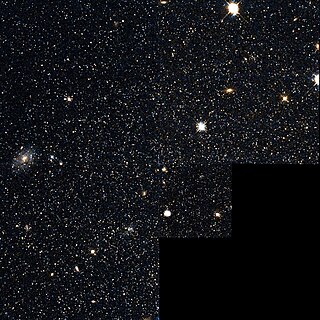 W
WAndromeda I is a dwarf spheroidal galaxy (dSph) about 2.40 million light-years away in the constellation Andromeda. Andromeda I is part of the local group of galaxies and a satellite galaxy of the Andromeda Galaxy (M31). It is roughly 3.5 degrees south and slightly east of M31. As of 2005, it is the closest known dSph companion to M31 at an estimated projected distance of ~40 kpc or ~150,000 light-years.
 W
WAndromeda II is a dwarf spheroidal galaxy about 2.22 Mly away in the constellation Andromeda. While part of the Local Group, it is not quite clear if it is a satellite of the Andromeda Galaxy or the Triangulum Galaxy.
 W
WThe Andromeda Galaxy, also known as Messier 31, M31, or NGC 224 and originally the Andromeda Nebula, is a barred spiral galaxy approximately 2.5 million light-years from Earth and the nearest major galaxy to the Milky Way. The galaxy's name stems from the area of Earth's sky in which it appears, the constellation of Andromeda, which itself is named after the Ethiopian princess who was the wife of Perseus in Greek mythology.
 W
WThe Andromeda–Milky Way collision is a galactic collision predicted to occur in about 4.5 billion years between the two largest galaxies in the Local Group—the Milky Way and the Andromeda Galaxy. The stars involved are sufficiently far apart that it is improbable that any of them will individually collide. Some stars will be ejected from the resulting galaxy, nicknamed Milkomeda or Milkdromeda.
 W
WAntlia-Sextans Group is a small grouping at the constellations Hydra, Sextans and Antlia. It is thought by some researchers to be at the very edge of the Local Group and thus part of it. Howewer, other researchers indicate it is an independent group, and thus the nearest group to the Local Group. It is, on average, approximately 4.3 million light-years away from the Milky Way.
 W
WThe Aquarius Dwarf is a dwarf irregular galaxy, first catalogued in 1959 by the DDO survey. It is located within the boundaries of the constellation of Aquarius. It is a member of the Local Group of galaxies, albeit an extremely isolated one; it is one of only a few known Local Group members for which a past close approach to the Milky Way or Andromeda Galaxy can be ruled out, based on its current location and velocity.
 W
WThe Carina Dwarf Spheroidal Galaxy is a dwarf galaxy in the Carina constellation. It was discovered in 1977 with the UK Schmidt Telescope by Cannon et al. The Carina Dwarf Spheroidal galaxy is a satellite galaxy of the Milky Way and is receding from it at 230 km/s. The diameter of the galaxy is about 1600 light-years, which is 75 times smaller than the Milky Way. Most of the stars in the galaxy formed 7 billion years ago, although it also experienced bursts of star formation about 13 and 3 billion years ago. It is also being tidally disrupted by the Milky Way galaxy.
 W
WThe Cassiopeia Dwarf is a dwarf spheroidal galaxy about 2.58 Mly away in the constellation Cassiopeia. The Cassiopeia Dwarf is part of the Local Group and a satellite galaxy of the Andromeda Galaxy (M31).
 W
WCetus Dwarf is a dwarf spheroidal galaxy. It lies approximately 2.46 Million light-years from Earth. It is an isolated galaxy of the Local Group, which also contains the Milky Way. All of the most readily observable stars in the galaxy are red giants.
 W
WThe Draco Dwarf is a spheroidal galaxy which was discovered by Albert George Wilson of Lowell Observatory in 1954 on photographic plates of the National Geographic Society's Palomar Observatory Sky Survey (POSS). It is part of the Local Group and a satellite galaxy of the Milky Way galaxy. The Draco Dwarf is situated in the direction of the Draco Constellation at 34.6° above the galactic plane.
 W
WThe Fornax Dwarf Spheroidal is an elliptical dwarf galaxy in the constellation Fornax that was discovered in 1938 by Harlow Shapley. He discovered it while he was in South Africa on photographic plates taken by the 24 inch (61 cm) Bruce refractor at Boyden Observatory, shortly after he discovered the Sculptor Dwarf Galaxy.
 W
WHercules, or Her, is a dwarf spheroidal galaxy situated in the Hercules constellation and discovered in 2006 in data obtained by the Sloan Digital Sky Survey. The galaxy is located at a distance of about 140 kpc from the Sun and moves away from the Sun with a velocity of about 45 km/s. It is classified as a dwarf spheroidal galaxy (dSph). It has a noticeably elongated shape with a half-light radius of about 350 pc. This elongation may be caused by tidal forces acting from the Milky Way galaxy, meaning that Her is being tidally disrupted now. Her also shows some gradient of velocities across the galaxy's body and is embedded into a faint stellar stream, which also points towards its ongoing tidal disruption.
 W
WIC 10 is an irregular galaxy in the constellation Cassiopeia. It was discovered by Lewis Swift in 1887 and in 1935 Nicholas Mayall became the first to suggest that the object is extragalactic. Edwin Hubble suspected it might belong to the Local Group of galaxies, but its status remained uncertain for decades. The radial velocity of IC 10 was measured in 1962, and it was found to be approaching the Milky Way at approximately 350 km/s, strengthening the evidence for its membership in the Local Group. Its membership in the group was finally confirmed in 1996 by direct measurements of its distance based on observations of Cepheids. Despite its closeness, the galaxy is rather difficult to study because it lies near the plane of the Milky Way and is therefore heavily obscured by interstellar matter.
 W
WIC 1613 is an irregular dwarf galaxy, visible in the constellation Cetus near the star 26 Ceti. It was discovered in 1906 by Max Wolf, and is approaching Earth at 234 km/s.
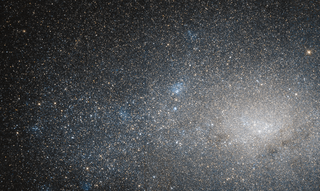 W
WIC 5152 is an irregular galaxy 5.8 million light-years from Earth in the constellation Indus. It was discovered by DeLisle Stewart in 1908. It is an open question as to whether it is an outlying member of the Local Group. It is one of the easiest galaxies to resolve into stars, but there is a bright foreground star right in front of it that makes deep observations difficult.
 W
WKKs 3 is a dwarf galaxy in the Local Cluster. It is unusual because it is gas poor and very isolated in the halo of the local group. KKs 3 is 7 million light years away from Earth. It is categorised as a dwarf spheroidal dSph galaxy. The mass of KKs 3 is 2.3 × 107M☉ (23 million times the mass of the Sun) with a blue absolute magnitude of −10.8. Three-quarters of its stars are over 12 billion years old. Coordinates are R.A. = 02h 24m 44.4s, Dec. = −73°30′51".
 W
WThe Large Magellanic Cloud (LMC) is a satellite galaxy of the Milky Way. At a distance of around 50 kiloparsecs (≈163,000 light-years), the LMC is the second- or third-closest galaxy to the Milky Way, after the Sagittarius Dwarf Spheroidal (~16 kpc) and the possible dwarf irregular galaxy known as the Canis Major Overdensity. Based on readily visible stars and a mass of approximately 10 billion solar masses, the diameter of the LMC is about 14,000 light-years (4.3 kpc), making it roughly one one-hundredth as massive as the Milky Way. This makes the LMC the fourth-largest galaxy in the Local Group, after the Andromeda Galaxy (M31), the Milky Way, and the Triangulum Galaxy (M33).
 W
WLeo A (also known as Leo III) is an irregular galaxy that is part of the Local Group. It lies 2.6 million light-years from Earth, and was discovered by Fritz Zwicky in 1942. The estimated mass of this galaxy is (8.0 ± 2.7) × 107 solar masses, with at least 80% consisting of an unknown dark matter. It is one of the most isolated galaxies in the Local Group and shows no indications of an interaction or merger for several billion years. However, Leo A is nearly unique among irregular galaxies in that more than 90% of its stars formed more recently than 8 billion years ago, suggesting a rather unusual evolutionary history. The presence of RR Lyrae variables shows that the galaxy has an old stellar population that is up to 10 billion years in age.
 W
WLeo I is a dwarf spheroidal galaxy in the constellation Leo. At about 820,000 light-years distant, it is a member of the Local Group of galaxies and is thought to be one of the most distant satellites of the Milky Way galaxy. It was discovered in 1950 by Albert George Wilson on photographic plates of the National Geographic Society – Palomar Observatory Sky Survey, which were taken with the 48-inch Schmidt camera at Palomar Observatory.
 W
WLeo II is a dwarf spheroidal galaxy about 690,000 light-years away in the constellation Leo. It is one of 24 known satellite galaxies of the Milky Way. Leo II is thought to have a core radius of 178 ± 13 pc and a tidal radius of 632 ± 32 pc. It was discovered in 1950 by Robert George Harrington and Albert George Wilson, from the Mount Wilson and Palomar Observatories in California.
 W
WLeo IV is a dwarf spheroidal galaxy situated in the Leo constellation, discovered in 2006 in the data obtained by the Sloan Digital Sky Survey. The galaxy is located at the distance of about 160 kpc from the Sun and moves away from the Sun with the velocity of about 130 km/s. It is classified as a dwarf spheroidal galaxy (dSph) meaning that it has an approximately round shape with the half-light radius of about 130 pc.
 W
WThe Andromeda Galaxy (M31) has satellite galaxies just like the Milky Way. Orbiting M31 are at least 13 dwarf galaxies: the brightest and largest is M110, which can be seen with a basic telescope. The second-brightest and closest one to M31 is M32. The other galaxies are fainter, and were mostly discovered only starting from the 1970s.
 W
WThe Triangulum subgroup is made up of the Triangulum Galaxy (M33) and its satellites. Although the Triangulum Galaxy does not have any proven satellite galaxies, a number of galaxies are suspected of being in the system.
 W
WThe Magellanic Clouds are two irregular dwarf galaxies visible in the Southern Celestial Hemisphere; they are members of the Local Group and are orbiting the Milky Way galaxy. Because both show signs of a bar structure, they are often reclassified as Magellanic spiral galaxies. The two galaxies are:Large Magellanic Cloud (LMC), approximately 163,000 light-years away Small Magellanic Cloud (SMC), approximately 206,000 light years away
 W
WMessier 32 is a dwarf "early-type" galaxy located about 2.65 million light-years from Earth, appearing in the constellation Andromeda. M32 is a satellite galaxy of the Andromeda Galaxy (M31) and was discovered by Guillaume Le Gentil in 1749. M32 measures 6.5 ± 0.2 thousand light-years in diameter at the widest point.
 W
WMessier 110, or M110, also known as NGC 205, is a dwarf elliptical galaxy that is a satellite of the Andromeda Galaxy. Although Charles Messier never included the galaxy in his list, it was depicted by him, together with M32, on a drawing of the Andromeda Galaxy; a label on the drawing indicates that Messier first observed NGC 205 on August 10, 1773. The galaxy was independently discovered by Caroline Herschel on August 27, 1783; her brother William Herschel described her discovery in 1785. The suggestion to assign the galaxy a Messier number was made by Kenneth Glyn Jones in 1967, making it the last member of the Messier List.
 W
WNGC 147 is a dwarf spheroidal galaxy about 2.58 Mly away in the constellation Cassiopeia. NGC 147 is a member of the Local group of galaxies and a satellite galaxy of the Andromeda Galaxy (M31). It forms a physical pair with the nearby galaxy NGC 185, another remote satellite of M31. It was discovered by John Herschel in September 1829. Visually it is both fainter and slightly larger than NGC 185. This means that NGC 147 is more difficult to see than NGC 185, which is visible in small telescopes. In the Webb Society Deep-Sky Observer's Handbook, the visual appearance of NGC 147 is described as follows: Large, quite faint, irregularly round; it brightens in the middle to a stellar nucleus.
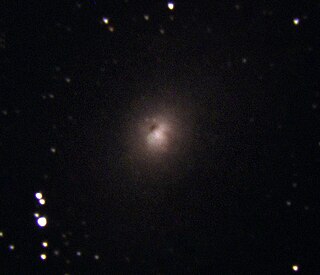 W
WNGC 185 is a dwarf spheroidal galaxy located 2.08 million light-years from Earth, appearing in the constellation Cassiopeia. It is a member of the Local Group, and is a satellite of the Andromeda Galaxy (M31). NGC 185 was discovered by William Herschel on November 30, 1787, and he cataloged it "H II.707". John Herschel observed the object again in 1833 when he cataloged it as "h 35", and then in 1864 when he cataloged it as "GC 90" within his General Catalogue of Nebulae and Clusters. NGC 185 was first photographed between 1898 and 1900 by James Edward Keeler with the Crossley Reflector of Lick Observatory. Unlike most dwarf elliptical galaxies, NGC 185 contains young stellar clusters, and star formation proceeded at a low rate until the recent past. NGC 185 has an active galactic nucleus (AGN) and is usually classified as a type 2 Seyfert galaxy, though its status as a Seyfert is questioned. It is possibly the closest Seyfert galaxy to Earth, and is the only known Seyfert in the Local Group.
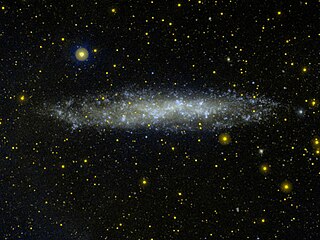 W
WNGC 3109 is a small barred Magellanic type spiral or irregular galaxy around 4.34 Mly away in the direction of the constellation of Hydra. NGC 3109 is believed to be tidally interacting with the dwarf elliptical galaxy Antlia Dwarf. It was discovered by John Herschel on March 24, 1835 while he was in what is now South Africa.
 W
WNGC 6822 is a barred irregular galaxy approximately 1.6 million light-years away in the constellation Sagittarius. Part of the Local Group of galaxies, it was discovered by E. E. Barnard in 1884, with a six-inch refractor telescope. It is one of the closer galaxies to the Milky Way. It is similar in structure and composition to the Small Magellanic Cloud. It is about 7,000 light-years in diameter.
 W
WPalomar 4 is a globular cluster of the Milky Way galaxy. It was discovered in 1949 by Edwin Hubble and again in 1955 by A. G. Wilson. Based on measurements of the stars from the Gaia spacecraft, it is at least 65,000 light-years from the Sun.
 W
WPalomar 12 is a globular cluster in the constellation Capricornus.
 W
WThe Pegasus Dwarf Irregular Galaxy is a dwarf irregular galaxy in the direction of the constellation Pegasus. It was discovered by A. G. Wilson in the 1950s. The Pegasus Dwarf is a companion of the Andromeda Galaxy in the Local Group.
 W
WThe Pegasus Dwarf Spheroidal is a dwarf spheroidal galaxy about 2.7 million light-years away in the constellation Pegasus. The Pegasus Dwarf is a member of the Local Group and a satellite galaxy of the Andromeda Galaxy (M31).
 W
WPisces Dwarf is an irregular dwarf galaxy that is part of the Local Group. The galaxy, taking its name from the constellation Pisces where it appears, is suspected of being a satellite galaxy of the Triangulum Galaxy (M33). It displays a blueshift, as it is approaching the Milky Way at 287 km/s. It may be transition-type galaxy, somewhere between dwarf spheroidal and dwarf irregular. Alternatively, it may be a rare, but statistically acceptable, version of one of the two types.
 W
WThe Sagittarius Dwarf Irregular Galaxy (SagDIG) is a dwarf galaxy in the constellation of Sagittarius. It lies about 3.4 million light-years away. It was discovered by Cesarsky et al. on a photographic plate taken for the ESO (B) Atlas on 13 June 1977 using the ESO 1 meter Schmidt telescope.
 W
WThe Sagittarius Dwarf Spheroidal Galaxy (Sgr dSph), also known as the Sagittarius Dwarf Elliptical Galaxy, is an elliptical loop-shaped satellite galaxy of the Milky Way. It contains four globular clusters, with the brightest of them – NGC 6715 (M54) – being known well before the discovery of the galaxy itself in 1994. Sgr dSph is roughly 10,000 light-years in diameter, and is currently about 70,000 light-years from Earth, travelling in a polar orbit at a distance of about 50,000 light-years from the core of the Milky Way. In its looping, spiraling path, it has passed through the plane of the Milky Way several times in the past. In 2018 the Gaia project of the European Space Agency showed that Sgr dSph had caused perturbations in a set of stars near the Milky Way's core, causing unexpected rippling movements of the stars triggered when it moved past the Milky Way between 300 and 900 million years ago.
 W
WThe Sculptor Dwarf Galaxy is a dwarf spheroidal galaxy that is a satellite of the Milky Way. The galaxy lies within the constellation Sculptor. It was discovered in 1937 by American astronomer Harlow Shapley using the 24-inch Bruce refractor at Boyden Observatory. The galaxy is located about 290,000 light-years away from the Solar System. The Sculptor Dwarf contains only 4 percent of the carbon and other heavy elements in our own galaxy, the Milky Way, making it similar to primitive galaxies seen at the edge of the universe.
 W
WThe Small Magellanic Cloud (SMC), or Nubecula Minor, is a dwarf galaxy near the Milky Way. Classified as a dwarf irregular galaxy, the SMC has a diameter of about 7,000 light-years, contains several hundred million stars, and has a total mass of approximately 7 billion solar masses. The SMC contains a central bar structure, and astronomers speculate that it was once a barred spiral galaxy that was disrupted by the Milky Way to become somewhat irregular. At a distance of about 200,000 light-years, the SMC is among the nearest intergalactic neighbors of the Milky Way and is one of the most distant objects visible to the naked eye.
 W
WThis is a list of star-forming regions located in the Milky Way Galaxy and in the Local Group. Star formation occurs in molecular clouds which become unstable to gravitational collapse, and these complexes may contain clusters of young stars and regions of ionized gas called H II regions. Stars typically form in groups of many stars, rather than in isolation.
 W
WThe Triangulum Galaxy is a spiral galaxy 2.73 million light-years (ly) from Earth in the constellation Triangulum. It is catalogued as Messier 33 or NGC 598. The Triangulum Galaxy is the third-largest member of the Local Group of galaxies, behind the Milky Way and the Andromeda Galaxy. It is one of the most distant permanent objects that can be viewed with the naked eye.
 W
WThe Tucana Dwarf Galaxy is a dwarf galaxy in the constellation Tucana. It was discovered in 1990 by R.J. Lavery of Mount Stromlo Observatory. It is composed of very old stars and is very isolated from other galaxies. Its location on the opposite side of the Milky Way from other Local Group galaxies makes it an important object for study.
 W
WUGC 4879, which is also known as VV 124, is the most isolated dwarf galaxy in the periphery of the Local Group. It is an irregular galaxy at a distance of 1.38 Mpc. Low-resolution spectroscopy yielded inconsistent radial velocities for different components of the galaxy, hinting at the presence of a stellar disk. There is also evidence of this galaxy containing dark matter.
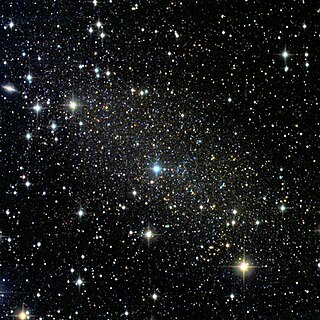 W
WThe Ursa Minor Dwarf is a dwarf spheroidal galaxy, discovered by A.G. Wilson of the Lowell Observatory, in the United States, during the Palomar Sky Survey in 1955. It appears in the Ursa Minor constellation, and is a satellite galaxy of the Milky Way. The galaxy consists mainly of older stars and seems to house little to no ongoing star formation. Its centre is around 225,000 light years distant from Earth.
 W
WThe Virgo Stellar Stream, also known as Virgo Overdensity, is the proposed name for a stellar stream in the constellation of Virgo which was discovered in 2005. The stream is thought to be the remains of a dwarf spheroidal galaxy that is in the process of merging with the Milky Way. It is the largest galaxy visible from the Earth, in terms of the area of the night sky covered.
 W
WThe Wolf–Lundmark–Melotte (WLM) is a barred irregular galaxy discovered in 1909 by Max Wolf, located on the outer edges of the Local Group. The discovery of the nature of the galaxy was accredited to Knut Lundmark and Philibert Jacques Melotte in 1926. It is in the constellation Cetus.